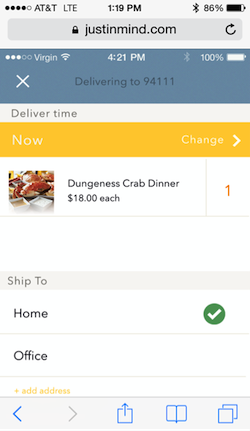I’ve had millions of ideas in my day. Most of them are terrible, but I’ve always lived with the frustration of not being able to realize them beyond mere conception. Sure, I could tell them to people, put that’s just air. I could write them down or try sketching them out, but that’s just chicken-scratch.
I want something tangible to hold in my hands; something that functions; something aesthetically pleasing; something I can let others interact with. I am not a coder, developer, or hacker. I don’t know much about business plans or startups. I consider myself an above average user of Microsoft Word, but I don’t think I’ve ever been able to connect to a printer without major assistance from someone in the IT Department.
So why did I agree to spend 13 hours on a beautiful Saturday attending the first ever ProtoHack? Because I enjoy lobster and crab and I like to collaborate. Organized by Rahul Nihalani and Cole Fox, this code-free hackathon at RocketSpace was my chance to manifest one of my splendid ideas. I didn’t need a specific skillset, I just needed to be semi-intelligent, assemble the right players, have some patience, and jump in with both feet.
But wait, didn’t I just say “lobster and crab?”
Lobster and Crab
Here in San Francisco there’s a service called Sprig that offers delivery of a rotating menu of fresh lunches and dinners during the week. Download the app, tap it a few times and Sprig will very quickly deliver a meal to your door.
Watching co-workers use Sprig, I’ve been impressed at the ease of the order and the speed of the delivery, and I’ve noticed several people at the office using Sprig multiple times a week. Well done, Sprig—solid model.
My idea (and remember, I’ve got millions of them) is to take this model and apply it to something a little more local than sandwiches and salads: Dungeness crabs and lobsters. This town is known for it’s excellent shellfish. It’s fancy and decadent, but not out of reach. It’s celebratory and fun, but accessible to anyone. With the right distribution model and local partnerships, I’ll be able to keep the costs down and the quality up.
I’m calling the business Bib and Butter. A name that’s fun and playful, and—if you’re not a baby who wears bibs because you smother your entire body in butter at every meal—one that implies shellfish without coming right out and saying it.
We’ll deliver fresh, seasonal crab and lobster to your door in under 30 minutes: pre-cooked, cracked, and packed in chilled biodegradable boxes along with a few lemons and, you guessed it, bibs and butter.
I’m ProtoHacking!
According ot its founders, ProtoHack exists to “… show ‘non-coders’ that they too can create something amazing from nothing. We want to empower you with the tools, knowledge and community to help you bring your idea to life and communicate it visually through prototyping.”
Anyone with an idea can come, work in a team, and rapidly prototype that idea with several online programs to choose from. At the end of the day, you actually have a working model of the idea brought to life.
The keynote speaker was none other than Gagan Biyani, the CEO of Sprig. He gave a good talk. I listened well because, after all, his business inspired Bib and Butter and I was going to completely rip him off.
Yes, there was background music throughout the day and it was awful. But the team and I powered through. Ignoring the audio was crucial to keeping our concentration and staying sane. Dozens of other teams huddled around tables throughout the space were all working away at a steady clip, blocking out unnecessary distractions as well.
Some teams were animated, gesturing wildly and nodding their heads frantically as they articulated their thoughts. Others were more somber, working in silence, completely oblivious to the sights, sounds, and smells (deli meat!) roiling around them. It was definitely a mixed bag of characters.
The whole vibe was very DIY. We had the option to use some of the online free prototyping tools like Proto.io, InVisionApp, Balsamiq, and POPApp or go at it with our own style of hand-to-hand combat. We chose the latter and quickly got down to business.
Collectively we wrote, researched, designed, built, and mapped-out the entire project in parallel. It was fast and fun. We slowed down for nothing. Then, after about nine hours, we were done. Bib and Butter had been brought to life!


Pop the Cork
The shellfish game was about to change and I took the squad out for dinner to celebrate (the pizza they were serving at the event wasn’t going to cut it for our newly refined palettes). We were going to be multi-millionaires soon, and needed fancy meats and cheeses and stemmed glassware to keep up appearances.
I’m months away from raising my first $10 million in funding, and a year away from selling the company and all the data I’ll gather on Bay Area shellfish eaters to Google for $30 million, but now, thanks to ProtoHack, Bib and Butter has a working prototype.
I’m a year away from selling to Google for $30m but thanks to @ProtoHack, I have a prototype
The next ProtoHack is scheduled for Saturday, August 19 in San Fransicso. Click here for more info.
Photo of cooked lobster courtesy Shutterstock













